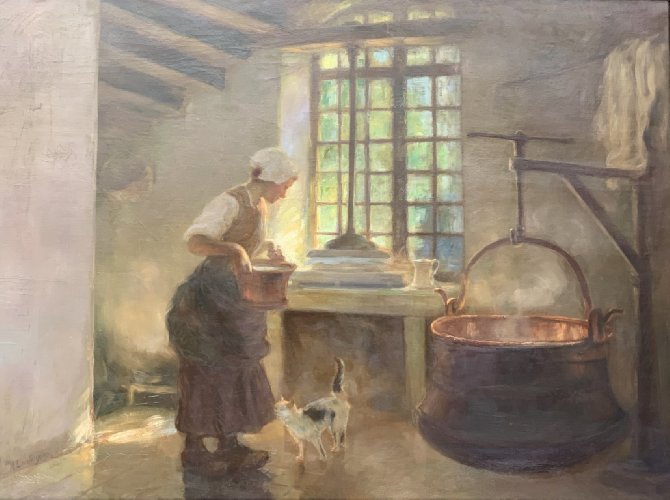Description:
Alfred-Louis Lorieux (1862-1946) was a French painter who studied under Gaston La Touche in Paris. He was a member of the Société des Artistes Français, exhibiting at their salons for several years. His work was mainly genre and religious painting*.
Description of the painting:
The painting shows the interior of a cheese-making workshop. The viewer has the opportunity to observe the cheese-making process. The first thing noticed is a copper boiler emerging from the shadows, suspended on a special structure. Steam rises from its interior. Based on the recipes for cheese-making, milk is probably inside. Above it hangs a white fabric used to dry the cheese mass. Towards the boiler, from the left edge of the painting, a woman is shown in profile. She is wearing a white shirt, skirt, an apron over it, and massive wooden clogs. Her hair is hidden under a white cap. In her hands she carries a copper vessel filled with another ingredient for cheese-making. At her feet lies a white-gray cat, to which she has turned her face. The background of the scene is the interior of the room, lit by a large window divided into small sections, behind which the crowns of trees can be seen in shades of yellow and green. In front of the window a table with a cheese press is set up, in which a portion of cheese is forming. The left part of the image is closed by a wall, behind which the entrance to the staircase is visible.
The composition is a game of vertical and horizontal lines softened by a climbing staircase in the upper left corner and curves of a vessel in the foreground. The painting is kept in almost monochromatic colors based on shades of brown and yellow. This gives the impression of warmth emanating from the work, and the room seems cozy. This is also emphasized by the shiny surface of the copper vessels. The combination of the used coloristic and the captured scene almost invites the viewer to look longer at the picture. The element distinguished by color is the view from the window, which introduces green shades. The window also becomes the central point of the composition through the light it introduces into the work. The left part of the picture plane is bathed in rays penetrating through the windowpanes. The work becomes a study of light in a certain dimension, which the artist tries to reflect in the monochromatic interior. The captured scene is a representation of everyday life, a frame from the cheese factory.


